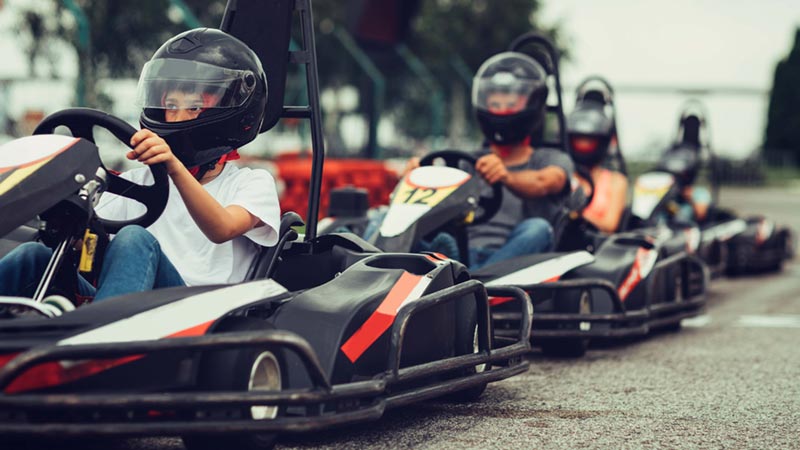Go-kart racing can be a competitive motorsport and every professional kart racer had to start at the beginning. In other words, they needed to learn how to drive a go-kart for the first time.
In this guide, we’ll be exploring the most essential go-kart racing tips and tricks for beginners, who are getting behind the steering wheel of a go-kart for the very first time. These tips are essential to ensuring a safe and fun karting experience.
If you’re planning your first race, simply read this guide, head to your favorite go-kart location and race a few laps with a rental go-kart. Once you’ve conquered the beginner tips, you can proceed to the more advanced go-kart racing guide that is designed to help you win races.
1. Study the Track You’ll Be Racing on
One important tip when racing go-karts for the first time is to get familiar with the track that you will be racing on. Most of the indoor karting locations will have a map of the track, where you will be able to see all the turns, chicanes and straight sections.
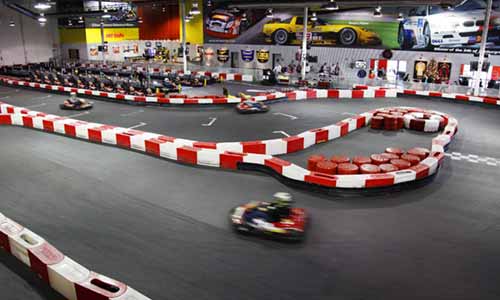
Things to learn:
- Corners
- Straight sections
- Starting position
- Overtaking opportunities
This will give you the opportunity to identify potentially challenging areas of the track beforehand, and lets you plan your approach and strategy well in advance.
Getting familiar with a track is extremely important and at the same time will help you improve your lap times. Even professional go-kart racers struggle with new race track layouts from time to time, so you can only benefit from this!
2. Observe and Learn From Others
Most people learn by doing. However, one step before racing go-karts that you should consider is observing how other racers approach the race course.
There are several key things that you will be able to learn by observing other racers:
- Braking patterns
- Overtaking opportunities
- Cornering techniques
- Steering wheel position
There are plenty of other things you’ll be able to pick up. Just take note that you want to observe intermediate to professional racers. They have gone through the same steps as you right now, when they first started out.
In addition to that, don’t be afraid to ask racers, track marshals or staff for help if you require it. Most of these locations offer great introductory racing classes or even free crash courses.
3. Select the Right Go-Kart
Before actually getting behind the steering wheel, you’ll want to ensure that you pick the right go-kart according to your age, weight, height and skill. If you’re visiting your local race track, chances are they will have several arrive and drive packages to choose from.
These packages are usually structured according to the number of races and the go-kart type. Most commonly, there are adult, junior and two-seater go-karts. You can use below as reference:
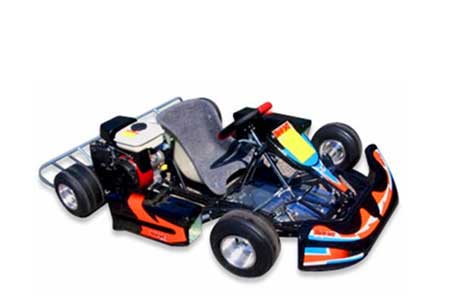
Junior Karts
Driver Height: 4’1” – 5’3”
Driver Age: 6 – 12 Years
Driver Weight: max. 280lbs
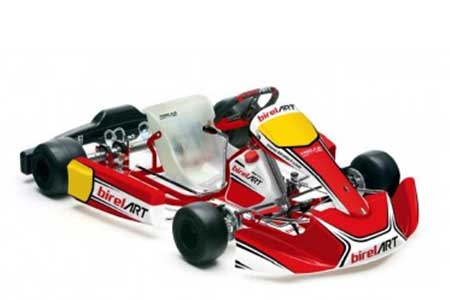
Adult Karts
Driver Height: 5’1” – 6’7”
Driver Age: 12+ Years
Driver Weight: max. 300lbs
As this is your first race, it’s highly recommended that you pick a single seater go-kart. Pick the right go-kart for your height, age and weight. When in doubt, let the personnel at the track assign a go-kart for you.
4. Understand How a Go-Kart Functions
Another important factor when driving a go-kart for the first time is understanding how a go-kart works. A go-kart is racing vehicle that contains many different components and it’s important that you acquaint yourself with its most important parts:
- Accelerator pedal
- Brake pedal
- Seat belt
- Steering wheel
- Safety bumpers
Most go-karts have a similar setup, which means that you will be accelerating with your right foot and breaking with your left foot. Before racing, request help from an instructor to show you where the above listed parts are located.
5. Dress Appropriately
You should always ensure that you have the right outfit for racing. This is true for any type of racetrack, whether it’s racing with gas-powered go-karts outdoors or electric go-karts indoors. Here is a quick list of the most important points when it comes to the go-kart racing dress code:
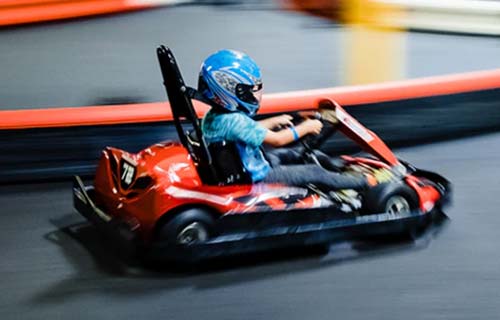
Clothing Tips for Racing:
- Wear fully enclosed shoes
- Tie up long hair
- Avoid loose clothing
- Remove accessories
You should always make sure to wear fully enclosed shoes, as go-kart parts can get hot and they also help to protect your feet. If you have long hair, you should tie it. It’s also best to wear tighter fitting clothes, as loose clothes like skirts and hoodies can get caught in some of the components.
Lastly, make sure to remove anything that can easily detach, get caught or impair vision. Therefore, remove accessories such as sunglasses, caps and hats.
6. Wear Appropriate Safety Gear
Whether you’re a professional go-kart race or racing for the first time, safety is always the most important aspect or any motorsport. In light of that, you’ll need to make sure that you have the right safety gear equipped.
You should always be wearing a karting helmet, especially if it’s your first time racing. This is because it protects your head in case of a collision, which is crucial on the race track.
Most of the go-kart racing locations will provide you with basic racing equipment, such as a helmet and a balaclava. It’s highly recommended not to race karts without a helmet.
More Information: Go-Kart Racing Safety Gear
7. Request For Help When Required
When purchasing your first go-kart racing tickets (usually via arrive and drive packages), let the ticketing officer know that this is your first time racing. They will most often point you to an instructor, who is sometimes also the track mashal. They will give all first time drivers a crash course.
You should also take this opportunity to ask them anything about racing go-karts. They will be more than happy to help.
8. Wear a Seatbelt
If you’re racing go-karts at an indoor race track, you’ll notice that most of the go-karts have a safety belt, strap or harness. This allows you to buckle up or strap yourself in.
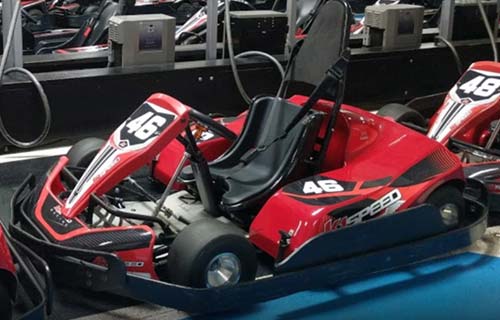
These safety devices are designed to keep you in your seat at all times – also in the event of a collision. You should fasten your seatbelt the moment you are seated and you should only remove your seat belt once all go-karts have come to a stop and the race is finished.
Remember: Keep yourself belted up at all times and enjoy the ride!
9. Follow the Track Rules
Before visiting the go-kart track of your choice, you should ensure that you fully understand the rules and regulations. Each location will have their house rules that you should follow at all times.
Here are some important rules and racing requirements that you should look out for before visiting the go-kart track of your choice:
- Age (minimum age requirements)
- Height (minimum height requirement)
- Safety Gear (list of mandatory safety equipment)
- Cost (racing packages)
- License (membership and/or driver’s license requirements)
- Waivers (waiver requirements for youths and kids)
During each race, you’ll also see a track marshal trackside. You should make an effort to understand all of the racing flags, so that you’ll know what the track situation is and if you need to be cautious. Most of the time, the team will explain the rules and also the meaning of go-kart racing flags.
Remember: When in doubt, slow down and request for assistance.
10. Drive Cautiously
Perhaps, one of the most important guidelines when it comes to first time go-kart racers is driving the go-kart cautiously. Everyone wants to finish the race in first place, but if you’re new to go-kart racing, you’ll need to get the hang of it first.
Here are some valuable racing tips for first-timers:
- Remain Calm: Race calmly and cautiously, only overtaking and speeding when required. Try not to panic, even when other go-karts are passing you.
- Look Ahead: Do not lose focus while racing and look straight ahead. Only turn your head when overtaking or when another kart is pulling up. Looking elsewhere may cause you to lose focus, which could potentially cause an accident.
- Don’t Drift: Even though it may look cool, drifting go-karts around corners is not only inefficient, but it can also be dangerous if you aren’t sure what you’re doing. You may accidentally oversteer and block the entire track or even worse, collide with another go-kart.
- Avoid Aggression: It may be frustrating at first when you see more experienced go-kart racers overtaking you. Try not to get intimidated by them and race against yourself, not against others. Your time will come!
I certainly hope this guide is helpful to anyone who has decided to race go-karts for the first time. While it may initially be intimidating, nothing comes close to the adrenaline rush you feel when you zoom around corners and overtake others!
Take each step, one at a time and remember to always seek for help or assistance when required. The go-kart racing community is generally warm and welcoming, so don’t be afraid to ask!
I wish you all a great race and hope you enjoy it!
